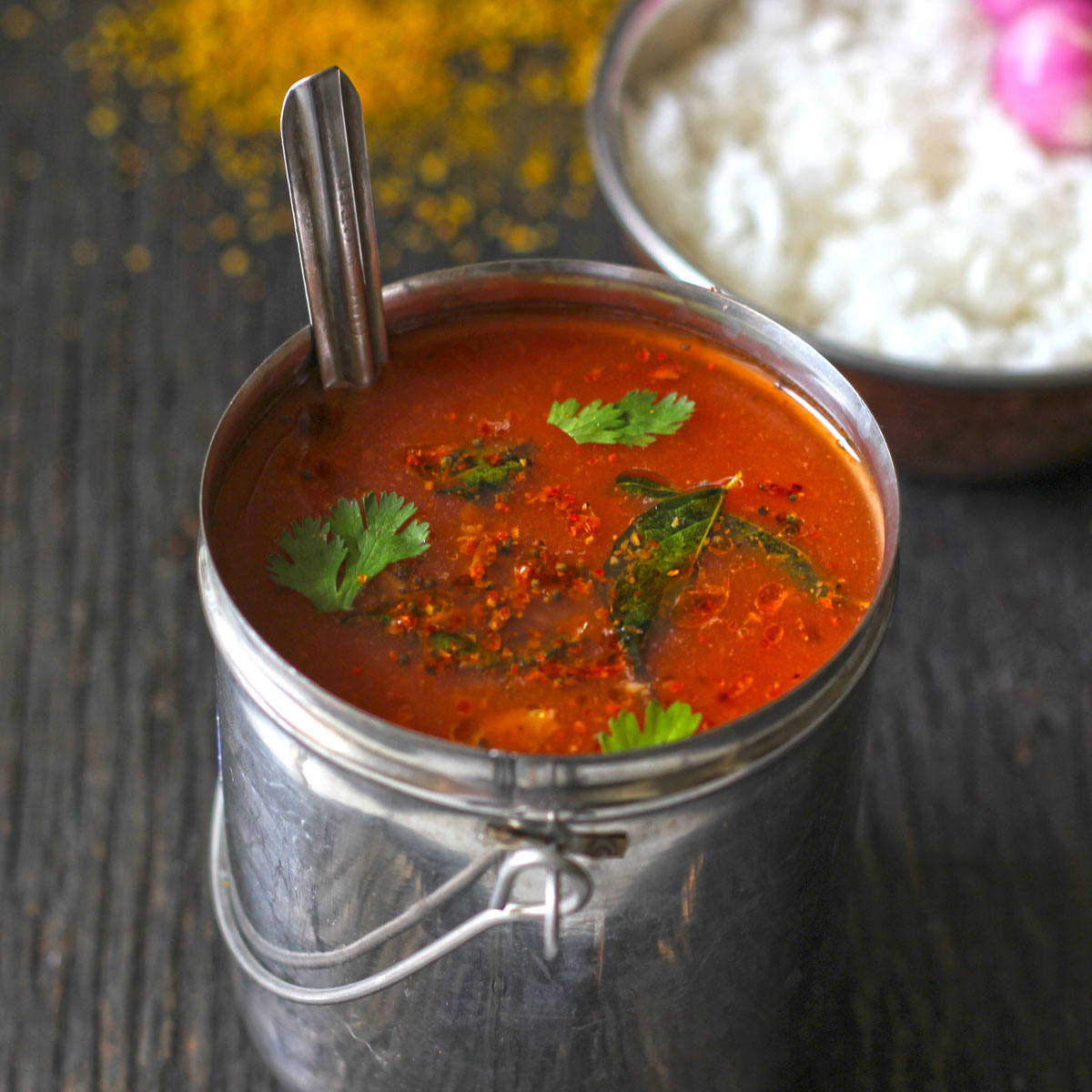Tomato rasam, a quintessential South Indian dish, is a delectable concoction of tangy tomatoes, aromatic spices, and soothing lentils. Its origins can be traced back to the vibrant streets of Tamil Nadu, where it has evolved into an indispensable part of the culinary landscape.
This versatile dish serves as an appetizing appetizer, a comforting soup, or a flavorful accompaniment to a traditional Indian meal.
Join us on a culinary adventure as we delve into the secrets of preparing an authentic tomato rasam. From the carefully selected ingredients to the step-by-step instructions, we’ll guide you through the process of creating this flavorful dish in the comfort of your own kitchen.
Along the way, we’ll explore the cultural significance of tomato rasam and uncover its hidden health benefits.
Introduction
Tomato rasam is a popular South Indian dish that is known for its tangy, spicy, and comforting flavor. It is a staple in many Indian households and is often served as an accompaniment to rice, idli, or dosa. Tomato rasam is also a great way to use up leftover tomatoes.
Origin and History
The exact origins of tomato rasam are unknown, but it is believed to have originated in the Tamil Nadu region of India. Tomatoes were introduced to India by the Portuguese in the 16th century, and they quickly became a popular ingredient in many Indian dishes.
Rasam is a traditional South Indian soup that is typically made with tamarind, spices, and lentils. Over time, tomatoes were added to rasam, creating the dish that we know today as tomato rasam.
Ingredients
Tomato rasam is a comforting and flavorful South Indian soup made with ripe tomatoes, lentils, and spices. It is a versatile dish that can be enjoyed as a starter, a side dish, or even as a light meal. The ingredients used in tomato rasam are simple and easily available.
The essential ingredients used in tomato rasam are as follows:
| Ingredient | Quantity | Purpose | Optional Variations |
|---|---|---|---|
| Tomatoes | 4-5 medium-sized | Provide the base flavor and color to the rasam | Can use cherry tomatoes or canned tomatoes |
| Tur dal | 1/2 cup | Lends a nutty flavor and thickness to the rasam | Can use toor dal or masoor dal |
| Tamarind | 1 small lemon-sized | Adds a sour and tangy flavor to the rasam | Can use tamarind paste or lemon juice |
| Cumin seeds | 1 teaspoon | Provides a warm and earthy flavor | Can add coriander seeds or fenugreek seeds |
| Mustard seeds | 1 teaspoon | Adds a pungent and slightly bitter flavor | Can use black mustard seeds or brown mustard seeds |
| Red chili powder | 1 teaspoon | Provides heat and spice to the rasam | Can adjust the quantity according to taste |
| Turmeric powder | 1/2 teaspoon | Adds a yellow color and a slightly bitter flavor | Can use a pinch of asafoetida |
| Salt | To taste | Enhances the overall flavor of the rasam | Can add a pinch of sugar for balance |
Step-by-Step s
To prepare a delicious and flavorful tomato rasam, follow these step-by-step s:
- Heat oil in a pan: In a deep-bottomed pan, heat some vegetable oil over medium heat.
- Add mustard seeds and cumin seeds: Once the oil is hot, add mustard seeds and cumin seeds. Let them crackle and splutter.
- Add chopped tomatoes: Add the chopped tomatoes to the pan and sauté for 4-5 minutes until they become soft and mushy.
- Add tamarind pulp and jaggery: Add tamarind pulp and jaggery to the pan. Stir well and cook for 2-3 minutes.
- Add rasam powder and turmeric powder: Stir in the rasam powder and turmeric powder. Cook for another 1-2 minutes.
- Add water: Add 2-3 cups of water to the pan. Bring to a boil.
- Add salt and coriander leaves: Add salt to taste and stir in the chopped coriander leaves.
- Serve hot: Serve the tomato rasam hot with rice or idlis.
Variations and Substitutions

Tomato rasam offers flexibility in its preparation, allowing for variations and substitutions to suit diverse preferences and dietary restrictions.
Variations
Lentil Variations
Rasam can be prepared with various lentils, including toor dal, masoor dal, or a combination of both. Each lentil imparts a slightly different flavor and texture to the dish.
Vegetable Variations
Enhance the rasam by adding chopped vegetables such as carrots, celery, or bell peppers. These vegetables provide additional nutrients and flavor.
Substitutions
Gluten-Free Option
For individuals with gluten sensitivities, use gluten-free asafoetida instead of regular asafoetida.
Dairy-Free Option
If desired, replace the yogurt with coconut milk to create a dairy-free version of tomato rasam.
Vegan Option
For a vegan version, use plant-based yogurt or cashew cream instead of regular yogurt.
Serving Suggestions
Traditionally, tomato rasam is served hot as a soup or an accompaniment to a meal. It is often paired with rice dishes such as plain rice, lemon rice, or curd rice.
Tomato rasam can also be enjoyed as a flavorful appetizer or a light snack. It is a versatile dish that can be customized to suit personal preferences and dietary restrictions.
Complementary Dishes
Some complementary dishes that pair well with tomato rasam include:
- Idli: Steamed rice and lentil cakes that are soft and fluffy.
- Dosa: Thin, crispy crepes made from fermented rice and lentil batter.
- Vada: Deep-fried lentil dumplings that are crispy on the outside and soft on the inside.
- Papad: Thin, crispy lentil crackers that are often served as a snack or appetizer.
- Yogurt: A cooling and refreshing accompaniment that helps balance the spiciness of the rasam.
Health Benefits
Tomato rasam is not only a delicious and comforting dish but also a nutritious one. It is packed with essential vitamins, minerals, and antioxidants that offer a range of health benefits.
The primary ingredient, tomatoes, is a rich source of lycopene, a powerful antioxidant linked to reduced risk of chronic diseases such as heart disease and cancer. Tomatoes also provide vitamins C, A, and potassium, which contribute to immune system health, vision, and blood pressure regulation.
Digestive Health
Rasam contains spices like cumin, coriander, and black pepper, which aid in digestion and reduce bloating. The tamarind in rasam has laxative properties that help regulate bowel movements and prevent constipation.
Anti-inflammatory Properties
Turmeric, a key ingredient in rasam, is known for its anti-inflammatory properties. It contains curcumin, which has been shown to reduce inflammation throughout the body, including in the joints and digestive system.
Tips and Tricks
Mastering the art of preparing a delectable tomato rasam requires a combination of culinary knowledge and practical tips. Embark on a journey to enhance your rasam-making skills with these valuable insights and troubleshooting advice.
Unleash the vibrant flavors of tomato rasam by incorporating fresh, ripe tomatoes. Their natural sweetness and acidity create a harmonious balance that elevates the dish.
Troubleshooting Common Challenges
- Rasam is too watery: Simmer the rasam for a longer duration to reduce the liquid and intensify the flavors.
- Rasam lacks spice: Adjust the amount of chili powder and other spices to suit your desired level of heat.
- Rasam is too sour: Balance the sourness by adding a touch of jaggery or sugar.
- Rasam is not flavorful enough: Experiment with different combinations of spices, such as adding a pinch of cumin or fenugreek seeds, to enhance the depth of flavor.
Cultural Significance
Tomato rasam is a beloved staple in Indian society, holding a significant cultural position. Its vibrant red hue and tangy flavor have made it an indispensable part of traditional festivals, celebrations, and everyday meals.
In Religious Ceremonies
Rasam plays a vital role in religious rituals, particularly in South India. It is considered an auspicious offering to deities and is often prepared during temple festivals and special occasions. The aromatic spices and healing properties of rasam are believed to purify the body and mind, making it a sacred dish in Hindu tradition.
At Weddings and Celebrations
Tomato rasam is a customary dish served at weddings, anniversaries, and other joyous events. Its tangy flavor is believed to balance the richness of the other dishes in the feast, and its bright color adds to the festive atmosphere. Rasam is also known for its digestive properties, making it a perfect accompaniment to the elaborate meals served at celebrations.
In Everyday Meals
In many Indian households, tomato rasam is a comforting and versatile dish that finds its place in everyday meals. Its simple preparation and nutritious ingredients make it a quick and easy option for busy families. Rasam can be paired with rice, idli, dosa, or simply enjoyed as a soup, offering a tangy and flavorful addition to the meal.
Last Recap

As we conclude our exploration of tomato rasam, we hope you’ve gained a newfound appreciation for this culinary gem. Whether you’re a seasoned cook or a novice in the kitchen, we encourage you to experiment with this recipe and make it your own.
The versatility of tomato rasam allows for endless variations, so feel free to adjust the ingredients and spices to suit your taste preferences. Remember, cooking is a journey of discovery, and each dish you create holds the potential for a unique and unforgettable experience.
FAQs
Can tomato rasam be made without lentils?
Yes, tomato rasam can be made without lentils. However, lentils add a distinct texture and nutritional value to the dish. If you choose to omit lentils, you can increase the quantity of tomatoes or vegetables to maintain the desired consistency.
What are some common variations of tomato rasam?
Tomato rasam offers a wide range of variations. You can add different types of lentils, such as masoor dal or moong dal, to create variations in texture and flavor. Additionally, you can incorporate vegetables like carrots, beans, or spinach to enhance the nutritional value and add a pop of color.
How can I make tomato rasam spicier?
To increase the spiciness of tomato rasam, you can add more red chili powder or green chilies to the recipe. Alternatively, you can use hotter varieties of chili peppers, such as cayenne or habanero peppers. Adjust the quantity of chilies according to your desired level of spiciness.
